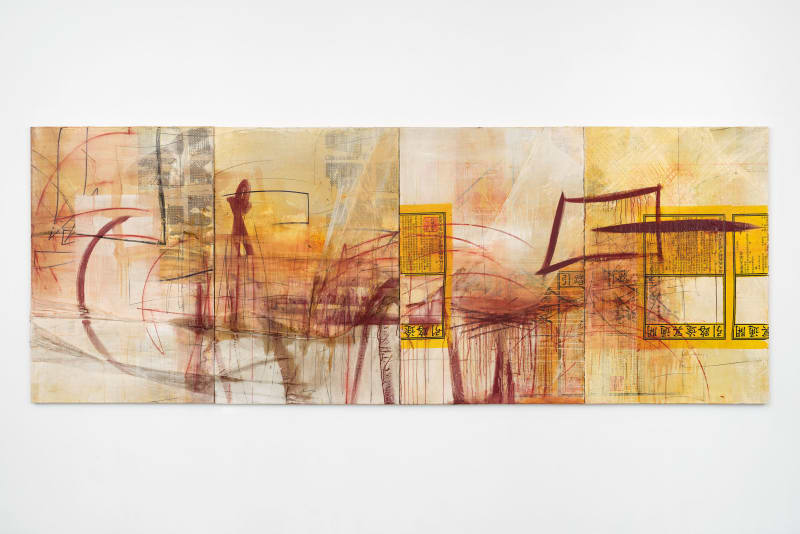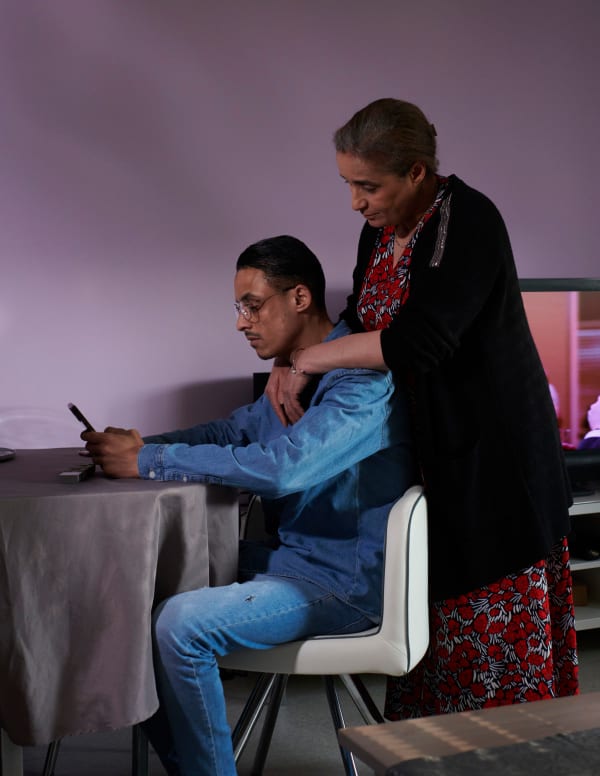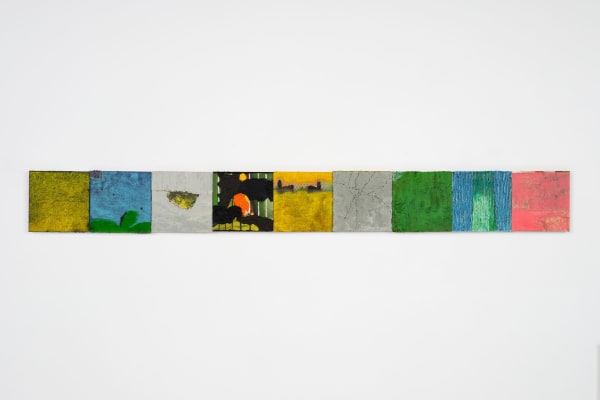The Miraculous Arms: Group Exhibition
I watch
the smoke rushes like a mustang to the front of the stage briefly hems its lava with its fragile peacock
tail then tearing its shirt suddenly opens its chest and I watch it dissolve little by little into
British Isles into islets into shredded rocks in the limpid sea of the air
where prophetically bathe
my mug
my revolt
my name
Aimé Césaire. “Prophecy.” The Miraculous Arms, 1946.
In 1946, Martinican writer and later politician Aimé Césaire published his prominent collection of surrealist poems and plays titled “The Miraculous Arms.” Cherished for his literary verve and his political lucidity, Césaire coined the concept of Négritude, a movement in African and Caribbean cultures for art and poetry as a revolt for self-determination, solidarity, and cultural identity. His miraculous arms, or weapons, were words of protest and dreams, through which he reminded us that poetics and politics have the power to transform the world we live in and retrieve what our societies chose to forget.
Inspired by the writings of Césaire, the exhibition brings together a heterogeneous ensemble of paintings, drawings, photographs, films, sculptural installations and sound elements produced by seven international artists who explore the social, political, intellectual, and cultural complexity of our post-colonial realities and spaces. The presented works challenge our gaze on the fetishized and marginalized body, and tackle relationships of domination, power, and questions of race.
The artists here find resilience. Touching our vulnerability, both personal and collective, they reveal how urgent it is we pull together and the joyful moments of grace we can find there when we do. Since all that’s left is each other, the exhibition suggests that Césaire’s miraculous arms might be the ones that ultimately hold, protect and elevate us.
Curated by Martha Kirszenbaum
Karimah Ashadu explores in her films and installations labor and self-determination practices pertaining to the social, economic, and cultural context of Nigeria and its diaspora. Machine Boys (2024) portrays a gang of motorcycle taxis known as okada in the megacity of Lagos, revving up for business despite official bans. The riders embody a particular kind of masculinity through their stylish attire and self-assured behavior. Alongside Machine Boys, Cowboy (2022) tells the story of a protagonist deftly and poetically relating to aspects of colonial structures and black history, and captivates with its beauty and sensuality. The work is split between two channels—one shows swaying palm trees in the wind interspersed with rushing ocean waves, while the other introduces us to the eponymous “Cowboy” who has dedicated his life to the care of horses. Through this exploration of Nigerian patriarchal ideals, Ashadu relates the performance of masculinity to the vulnerability experienced by a precarious class of workers.
In a practice spanning photography, film, installation, sculpture, and drawing, Mohamed Bourouissa addresses systems of power and domination, as well as the politics of representation. Rooted in the post-colonial world and in French suburban culture, his work articulates notions of transgression and subjectivity while examining the social roles of the subaltern—immigrants, the impoverished, the voiceless. His breakthrough series of photographs, Périphérique, appropriates the codes of history painting by staging scenes with friends and acquaintances in the Paris suburbs where they used to hang out. Périphérique was first completed between 2005-2008, in the context of unprecedented violence and riots against social inequality in the French banlieues. The series depicts confrontations, gatherings, incidents, momentary glances, and frozen gestures, all suggesting palpable tensions. Bourouissa’s high drama in the outskirts of Paris attempts to give a place in French history to individuals and bodies of colors usually neglected and overlooked in contemporary society and in historiography.
For over four decades, Senga Nengudi has been pushing at the boundaries between sculpture, photography, and performance. In 1975, after the birth of her first son and prompted by the physical and psychological changes she experienced during pregnancy, Nengudi started making sculptures composed of ripped and tied flesh-toned pantyhose, expressing the human body’s elasticity and its ability to expand and contract. Tapping into the symbolic potential of fiber materials, and through stretching the tights into elongated linear forms, Nengudi gestures toward the movement and resistance of black women as they navigate prescriptive gender roles. The work presented in the exhibition is part of her “R.S.V.P.” series of sculptures and performances, the title of which is an abbreviation of the French phrase répondez s’il vous plaît (or “please respond”) and alludes to performances during which dancers enter and lean into the sculptures. In both action and stillness, Nengudi’s works demonstrate the tensile resilience of the material and, symbolically, of black women.
The multi-layered work of Pol Taburet brings together an expressive imagery of floating shapes and spectral shadows influenced by voodoo mysticism and spirituality. Taburet draws inspiration from Afro-Caribbean mythology and Guadeloupean oral culture, specifically tales transmitted by his mother, grandmother, and aunts. Combining an academic painting background with an experimental, often DIY sensibility, his ensembles of paintings, drawings, and sculptures break hierarchies and conventions. Here the artist’s approach can be perceived in the continuity of the writings of Martinician philosopher and poet Édouard Glissant, who coined the term “creolization” to define the blending of different cultures and experiences in the West Indies that resulted in a unique common language and iconography. His practice also draws references to popular culture like American trap music, both a subgenre of hip hop and a cultural movement that originated in the suburbs of Atlanta in the early 2000s. His newest series of charcoal drawings brings together African masks, references to hip hop’s Death Row label, and to the Dracula-esque film and literature character Candyman.
Salim Green’s painting practice puts in perspective concepts of visibility, concealment, and opacity. He looks to consider social perceptions of blackness, navigating built environments and strategies for that very navigation through different forms of abstraction. In his approach, Green often refers to the “Dark Forest Theory,” a speculative idea that interplanetary civilizations hide from each other out of self-preservation, and in order to prevent conflict over resources. Using this concept as a model for relational politics and black experience, Green’s work assumes the metaphorical position of hiding—from surveillance, the anxieties of others, domination, the state, overreaching publicity or visibility. In an attempt to find the right balance between texture, color, and composition, his latest series of paintings brings together small and large formats assembled in free forms. The works combine wool felt and found material rather than traditional canvas, and the physicality of the artist’s practice is revealed through his actions of scraping, pouring, and endless layering.
Developing her own methodologies of visual and sound archiving, Christelle Oyiri disrupts the spinning pinwheel of nostalgia. French-born from Ivorian and Guadeloupean descent, Oyiri’s identity is shaped by the diplomatic, social, and metaphysical conflicts inherited from colonization, and the trickle-down effect it has on cultural behaviors, familial history, and the experience of a wider African diaspora. COLLECTIVE AMNESIA (2018–2022) celebrates the forgotten history of Logobi—an Ivorian folk dance originating from the streets of Abidjan, Ivory Coast that emerged in Paris’s banlieues (suburbs) among Black French youth in the late 2000s through the early 2010s. HYPERFATE (2022) is a visual memento mori of rap culture, questioning notions of destiny and fate, and asking how rap, synonymous with initiatory narratives and success, became a mortuary factory for tragic heroes. For each of her films, she composes an accompanying score, shaping the silence and voices of her characters, the architectures of her digital animation, and her hybrid use of language.
From painting and writing to performance art, Minh Lan Tran explores in her multimedia practice interactions and resistances between language, movement, and material. More performative than gestural, Tran’s paintings incorporate principles of choreography as the artist carefully distributes different pigment intensities or layers across their surfaces, resulting in compositions that embody the fluidity of physical movement. Writing forms, from calligraphy to graffiti, are also foundational to her approach. Rooted in diverse traditions and histories, her canvases evoke themes of social upheaval and revolt, and channel spiritual and political expressions of protest. In the four-panel work Afterlife, Tran considers the importance of ritual and funerary tradition. She incorporates into the painting Joss or incense papers, which are commonly used as burnt offerings in Chinese ancestral worship. Fire and its purifying attributes bring the work’s surface to life through references to self-immolation practices among Buddhist monks.
Karimah Ashadu
Karimah Ashadu (b. 1985, London, UK) has been shown at institutions internationally, including the 60th Venice Biennale, where she was awarded the Silver Lion for a Promising Young Participant in the International Exhibition. Other selected exhibitions and screenings include the Tate Modern, London; Secession, Vienna; Kunstverein in Hamburg; South London Gallery, London; Centre d’Art Contemporain Genève. Ashadu was awarded the Prize of the Bötterstraße in Bremen (2022), the ars viva prize (2020) and was named Abigail R. Cohen 2021 Fellow at the Columbia Institute for Ideas and Imagination, Paris. Her work is included in public collections including MoMA, the City of Geneva Contemporary Art Collection and the Federal Collection of Contemporary Art, Germany. She lives and works between Hamburg and Lagos.
Mohamed Bourouissa
Mohamed Bourouissa (b. 1978, Bilda, Algeria) lives and works in Paris, France. Recent solo exhibitions include presentations at Palais de Tokyo, Paris (2024); Musée LaM, Villeneuve-d’Ascq (2023); Goldsmiths Centre for Contemporary Art, London (2021); Kunsthal Charlottenborg, Copenhagen (2021); ar/ge kunst, Bolzano (2020); Schinkel Pavillon, Berlin (2020). His work is included in public collections worldwide including Centre Pompidou, Paris; Fondation Louis Vuitton, Paris; Fonds National d’art contemporain, Paris; Los Angeles County Museum of Art, Los Angeles; Musée d’Art Moderne de la Ville de Paris, Paris; Philadelphia Museum of Art, Philadelphia; Pinault Collection, Paris; Stedelijk Museum, Amsterdam; among others. Bourouissa’s work has been the recipient of prizes including the Deutsche Börse Photography Foundation Prize (2020); Prix Fondation Blachère (2010); Prix Studio Collector, Fondation Antoine de Galbert (2007); and First Prize, Les Rencontres d’Arles (2007).
Salim Green
Salim Green (b. 1996, Hartford, CT) earned a BA from Wesleyan University in 2020 and an MFA from the University of California Los Angeles in 2024. Green’s work has been exhibited in solo and group exhibitions at Room 3557, Los Angeles; Ezra and Cecile Zilkha Gallery, Middletown; SculptureCenter, New York; Stony Island Arts Bank, Chicago; Fábrica, Mexico City. His work is included in the collections of the Getty Research Institute, The Underground Museum and the Tyler School of Art and Architecture, Temple University. He lives and works in Los Angeles.
Senga Nengudi
Senga Nengudi (b. 1943, Chicago) lives and works in Colorado Springs. Selected solo exhibitions include Dia: Beacon, Beacon; Philadelphia Museum of Art, Philadelphia; Denver Art Museum, Denver; Museo de Arte de São Paulo, São Paulo; Lenbachhaus, Munich; Henry Moore Institute, Leeds; Baltimore Museum of Art, Baltimore; Institute of Contemporary Art, Miami. Her work is included in the collections of Centre Pompidou, Paris; Hammer Museum, Los Angeles; The Israel Museum, Jerusalem; Los Angeles County Museum of Art, Los Angeles; Migros Museum, Zurich; Museum of Fine Art, Houston; Museum of Contemporary Art, Los Angeles; Museum of Modern Art, New York; Smithsonian American Art Museum, Washington, DC; Solomon R. Guggenheim Museum, New York; Tate Modern, London; Walker Art Center, Minneapolis; Whitney Museum of American Art, New York, among others.
Christelle Oyiri
Christelle Oyiri (b.1992, France), also known under the DJ pseudonym CRYSTALLMESS, lives and works in Paris, France. Her work has been exhibited in solo and group exhibitions around the world, including at Julia Stoschek Foundation, Berlin; Gladstone Gallery, New York City; Tramway, Glasgow; Haus der Kunst, Munich; Centre Pompidou, Paris; Lafayette Anticipations, Paris; Ars Electronica, Linz; among others. She was a resident of the Cité Internationale des Arts, Paris and Villa Albertine, New York City, and was the recipient of the Pontopries from the Museum für Moderne Kunst, Frankfurt in 2024.
Pol Taburet
Pol Taburet (b. 1997, Paris, France) attained his BA and MA at École Nationale Supérieure d’Arts de Paris-Cergy in 2019 and 2021. Recent solo exhibitions include Longlati, Shanghai; Mendes Wood DM, São Paulo; Pivô, São Paulo; Lafayette Anticipations, Paris; C L E A R I N G, Los Angeles. Recent group exhibitions include 24ème Prix Fondation Pernod Ricard, Paris; 6th Dhaka Art Summit, Dhaka; Reiffers Art Initiatives, Paris, among others. Taburet’s work is included in public collections including the Espoo Museum of Modern Art, Tapiola and the Pinault Collection, Paris. He lives and works in Paris, France.
Minh Lan Tran
Mihn Lan Tran (b. 1997, Hong Kong) studied Art History at the Ecole du Louvre, Paris and the University of Oxford. She holds an MA in Byzantine studies and visual theology from the Courtauld Institute of Art, London (2020) and an MA in Painting from The Royal College of Art, London (2023). Recent solo and duo exhibitions include Parliament, Paris; Jan Kaps, Cologne; Harlesden High Street, London; Nicoletti Contemporary, London. Recent group exhibitions include Balice Hertling, Paris; Francis Irv, New York; the Museum of the Home, London; Roman Road, London; among others. She lives and works in London.
Martha Kirszenbaum (b. 1983, France) is a curator, writer and editor based in Paris and Los Angeles. She graduated from Sciences-Po in Paris and Columbia University in New York with an M.A. in Political History and Cultural Studies. Kirszenbaum was the Curator of the French Pavilion of the 58th Venice Biennale represented by Laure Prouvost. She founded and directed Fahrenheit, an exhibition space and residency program in Los Angeles (2014–2017). Previously she acted as the Associate Curator at the Kunsthalle Mulhouse (2014) and as Curator-in-Residence at the Belvedere Museum/21er Haus in Vienna (2012) and at the Center for Contemporary Art in Warsaw (2010). She also held positions at the New Museum in New York (2008–2010), the Photography Department of Centre Georges Pompidou in Paris (2007) and the Media Department of MoMA in New York (2006–2007). Kirszenbaum has organized exhibitions, screenings, performances and talks at renowned international institutions such as the ICA in London, Palais de Tokyo in Paris, Astrup Fearnley Museet in Oslo, Kunstall Stavanger, Kistefos Museum in Norway, Beirut Art Center, Fondation Ricard in Paris, 221A in Vancouver, Kadist in Paris / San Francisco, Madre Museum in Naples, Pejman Foundation in Tehran, Los Angeles Contemporary Exhibitions, Marrakech Biennale, Istanbul Biennale, and the Austrian Cultural Forum NY. She is a regular contributor to Flash Art, Mousse, Kaleidoscope and CURA, where she also serves on the editorial board, and has led seminars at UCLA, Université Paris VIII, Malmö Art Academy. She served on the jury for the 2023 Pinchuk Art Prize, the Jan Van Eyck Academy, Rencontres d’Arles Prix Découverte, Cité Internationale des Arts, and is a member of the Advisory Board of Tselinny Art Center in Almaty, Kazakhstan.
-
 Minh Lan Tran, Afterlife, 2024
Minh Lan Tran, Afterlife, 2024 -
 Karimah Ashadu, Machine Boys, 2024
Karimah Ashadu, Machine Boys, 2024 -
 Senga Nengudi, R.S.V.P., 1976-2014
Senga Nengudi, R.S.V.P., 1976-2014 -
 Salim Green, Swamp Water, 2024
Salim Green, Swamp Water, 2024 -
 Salim Green, Tour Guide, 2024
Salim Green, Tour Guide, 2024 -
 Salim Green, Nax Steel, 2024
Salim Green, Nax Steel, 2024 -
 Mohamed Bourouissa, Le Bracelet, 2014
Mohamed Bourouissa, Le Bracelet, 2014 -
 Mohamed Bourouissa, Ma Mère, 2022
Mohamed Bourouissa, Ma Mère, 2022 -
 Mohamed Bourouissa, Alyssia, 2022
Mohamed Bourouissa, Alyssia, 2022 -
 Pol Taburet, Ballerines, 2024
Pol Taburet, Ballerines, 2024 -
 Pol Taburet, Eden's wall, 2024
Pol Taburet, Eden's wall, 2024 -
 Pol Taburet, Death Row, 2024
Pol Taburet, Death Row, 2024 -
 Christelle Oyiri, COLLECTIVE AMNESIA, 2018
Christelle Oyiri, COLLECTIVE AMNESIA, 2018 -
 Karimah Ashadu, Cowboy, 2022
Karimah Ashadu, Cowboy, 2022 -
 Christelle Oyiri, HYPERFATE, 2022
Christelle Oyiri, HYPERFATE, 2022 -
 Salim Green, Series 1 (you move like you’re ducking someone), 2024
Salim Green, Series 1 (you move like you’re ducking someone), 2024 -
 Salim Green, Series 5 (nudism in a cold climate #3), 2024
Salim Green, Series 5 (nudism in a cold climate #3), 2024 -
 Salim Green, Series 2 (relay race), 2024
Salim Green, Series 2 (relay race), 2024 -
 Salim Green, Series 4 (overproof), 2024
Salim Green, Series 4 (overproof), 2024 -
 Salim Green, Go in the gutter, find another, 2024
Salim Green, Go in the gutter, find another, 2024 -
 Salim Green, Misdirection, 2024
Salim Green, Misdirection, 2024 -
 Salim Green, Paranoid, 2024
Salim Green, Paranoid, 2024 -
 Salim Green, Series 4 (overproof), 2024
Salim Green, Series 4 (overproof), 2024 -
 Salim Green, Series 6 (Cuzzo), 2024
Salim Green, Series 6 (Cuzzo), 2024 -
 Salim Green, Series 7 (the bag may not inflate #2), 2024
Salim Green, Series 7 (the bag may not inflate #2), 2024


























